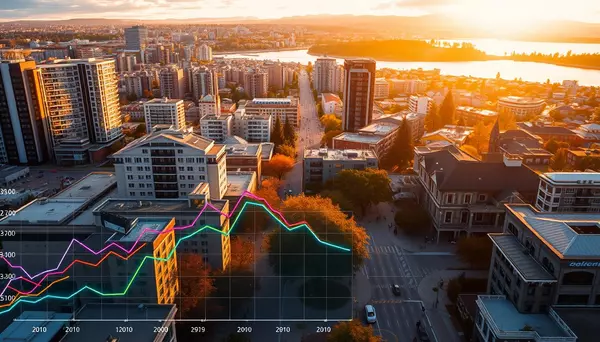Understanding Seasonal Trends in Victoria's Home Prices: A Comprehensive Analysis of Market Fluctuations
Are you considering buying a home in Victoria, BC, but unsure about the timing? Understanding seasonal trends in Victoria's home prices can significantly influence your decision. This article will analyze market fluctuations, explore how seasonal factors impact pricing, and provide insights on the best times to purchase. By engaging with this content, readers will gain valuable knowledge on navigating Victoria's housing market effectively, helping them avoid common pitfalls and make informed choices in their home-buying journey.
Identifying Seasonal Trends in Victoria's Home Prices
Victoria's real estate market exhibits distinct seasonal trends that influence home prices. This section examines historical price fluctuations, highlighting key seasonal indicators such as royal bay that affect market behavior. A yearly comparison of price changes will provide insights into how buying a house, environmental degradation and shifting retail demand impact pricing ratios, contributing to a deeper understanding of these fluctuations.
Overview of Historical Price Fluctuations
The historical fluctuations in home prices within Victoria have revealed notable patterns that correlate with seasonal changes. For instance, the average home prices tend to rise during the spring and summer months as buyer demand increases, often driven by factors such as the local ecosystem stability and sustainability initiatives. Conversely, during fall and winter, a decrease in market activity can often be seen, primarily due to climate considerations and the holiday season, which impacts overall sales and pricing dynamics.
Key Seasonal Indicators Affecting the Market
Key seasonal indicators significantly influence Victoria's real estate market and buyers’ decisions. Climate variability and change can affect property desirability, especially in regions vulnerable to extreme weather conditions, such as drylands. Moreover, shifts in biodiversity and ecosystem health may alter perceptions of investment value, as areas with high algal growth or other environmental concerns may see reduced demand, impacting home prices and market dynamics.
Yearly Comparison of Price Changes
Analyzing yearly price changes in Victoria's real estate market reveals a clear correlation between seasonal demand and home prices. For instance, when examining trends, spring and summer consistently demonstrate higher prices due to increased buyer activity, which aligns with factors such as local agricultural organization initiatives promoting sustainable practices. In contrast, the winter months often show dips, as vulnerability to harsh weather and reduced consumer activity, influenced by food delivery demands during holiday seasons, lead to a noticeable drop in emission intensity and overall sales prices.
Analyzing Market Fluctuations in Victoria
Understanding economic conditions is essential when analyzing market fluctuations in Victoria's real estate. Seasonal demand patterns among buyers often reflect shifts in welfare and productivity, influencing housing prices significantly. Additionally, the influence of market cycles on pricing can be likened to agricultural trends, where external factors, such as crop yields like rice, impact overall market behavior. Each of these aspects will be examined in detail.
Understanding Economic Conditions and Their Impact
Economic conditions profoundly influence Victoria's real estate market, shaping housing prices through various factors. For instance, changes in meteorology directly affect seasonal demand, where fluctuations in weather patterns can impact property desirability, especially in grassland and savanna areas prone to climatic events. Moreover, the push towards net zero emissions has led to increased investment in sustainable properties, as buyers prioritize eco-friendly features, a trend heightened during the pandemic when health and environmental considerations came to the forefront of buyer preferences.
Seasonal Demand Patterns Among Buyers
Seasonal demand patterns among buyers in Victoria’s real estate market are influenced by various factors, including concerns about the natural environment and the implications of global change. During peak seasons, buyers often prioritize properties that align with eco-friendly practices, reflecting a growing awareness of issues such as deforestation and decomposition in Southeast Asia. Understanding these seasonal fluctuations allows sellers to better tailor their strategies to address buyer preferences, ultimately enhancing their market position.
Influence of Market Cycles on Pricing
The influence of market cycles on pricing in Victoria's real estate landscape is marked by various factors, including consumption patterns and greenhouse gas emissions. As the demand for eco-friendly properties rises, influenced by global trends such as land change science, sellers must adapt their pricing strategies accordingly. For example, properties that emphasize sustainability features are often valued higher, reflecting buyers' priorities and concerns about environmental impacts, particularly in regions connected with Central America where awareness of climate issues is increasing.
How Seasonal Factors Impact Home Pricing in Victoria
Seasonal factors significantly impact home pricing in Victoria through various dimensions, including seasonal repairs and maintenance trends that prepare properties for market fluctuations. Trends in local inventory influence prices as supply and demand shift. Additionally, natural events play a critical role in seasonal pricing, affecting transportation logistics and emergency management challenges, particularly in light of biodiversity loss observed in areas like New South Wales.
Seasonal Repairs and Maintenance Trends
Seasonal repairs and maintenance trends in Victoria significantly affect home pricing during peak market periods. For instance, as spring approaches, homeowners often invest in landscaping and exterior maintenance to attract potential buyers, considering the implications of minimum wage fluctuations on renovation budgets. Moreover, properties situated in regions with higher biodiversity, particularly in southern Europe, may require more attention to prevent diseases affecting local species, ultimately enhancing their market value during peak seasons.
Trends in Local Inventory and Its Effect on Prices
Trends in local inventory play a crucial role in determining home prices within Victoria's real estate market. During peak seasons, the availability of properties increases, which can lead to a decline in prices as consumers have more options to choose from. Evidence suggests that when inventory levels rise, sellers may need to experiment with pricing strategies, factoring in repair and maintenance costs while managing the risk of extended listing times and additional fees associated with prolonged market presence.
The Role of Natural Events in Seasonal Pricing
Natural events play a significant role in shaping seasonal pricing in Victoria's real estate market. Factors such as extreme weather conditions and environmental changes can directly affect property values, ultimately influencing buyer behavior. For instance, adverse weather, which has been observed in regions like the Northern Territory and the Sahel, can deter potential buyers, prompting them to consider their living conditions more carefully, including aspects related to food sources and sustainability, thus affecting their purchasing decisions. Real estate agents must understand these dynamics and address shared socioeconomic pathways by informing clients about how natural events could impact property values and market trends.
Timing Your Purchase in Relation to Seasonal Trends
Timing a home purchase in Victoria's market involves recognizing the advantages of buying during off-peak seasons, where prices may be more favorable. It also requires understanding the risks associated with seasonal investment decisions, such as uncertainty brought on by external factors like wildfires and fluctuating water quality. Effective strategies for capitalizing on seasonal pricing can help navigate these challenges, particularly in regard to market influences from the food industry and regions like Wales.
Advantages of Buying During Off-Peak Seasons
Buying a home during off-peak seasons can offer significant advantages, particularly in terms of pricing and choice. Typically, home prices may be lower during these times, driven by reduced demand and the effects of precipitation on buyer activity. This allows purchasers to maximize their income potential by investing in properties that may align more closely with their budget, while also considering energy-efficient options that support ecological sustainability, a growing concern inspired by global contexts such as those observed in South America.
Risks Associated With Seasonal Investment Decisions
Investing in real estate during specific seasons in Victoria comes with inherent risks that buyers must carefully evaluate. Factors such as changing government policy and private sector influences can create market volatility, affecting home prices unpredictably. For instance, stimulus programs aimed at enhancing health care and environmental sustainability may alter buyer behavior, potentially leading to sudden market shifts. Similarly, environmental concerns, such as the increasing presence of insects from climate changes, can deter potential buyers, impacting long-term value. Buyers should remain vigilant of these variables to make informed decisions aligned with their financial goals.
Strategies for Capitalizing on Seasonal Pricing
To successfully capitalize on seasonal pricing in Victoria's real estate market, potential buyers should closely monitor fluctuations in interest rates and market conditions, as these can significantly impact affordability. For instance, during periods of drought, when the supply of properties may tighten due to environmental stress, buyers may find better deals if they act proactively in the off-peak months when competition is lower. Understanding the landscape of seasonal trends allows buyers to make informed decisions that align with their financial goals while maximizing opportunities presented by changing market dynamics.
Expert Insights on Victoria’s Housing Market
This section provides valuable insights into Victoria's housing market through interviews with local real estate experts, offering practical methodologies used to assess market fluctuations. It includes case studies of historical seasonal trends, examining the influence of tourism and cash versus credit transactions. Additionally, predictions for upcoming seasonal changes will highlight expected shifts, helping buyers and sellers navigate the evolving landscape.
Interviews With Local Real Estate Experts
Interviews with local real estate experts in Victoria reveal insightful perspectives on the impact of seasonal trends on home prices. These professionals emphasize that factors like air pollution levels and environmental conditions, akin to challenges observed in regions of Western Australia and Latin America, play a significant role in determining property desirability. They also discuss how habitat preservation initiatives can influence market dynamics, urging potential buyers to consider these external matters when making investment decisions.
Case Studies of Historical Seasonal Trends
Historical case studies in Victoria's housing market illustrate how seasonal trends can affect pricing and buyer behavior. During periods of strong economic growth, for instance, data revealed that home prices often spiked in spring, as favorable wind conditions helped enhance outdoor appeal, drawing in more buyers. Additionally, alignment with nutrient-rich agricultural cycles also influenced revenue generation for local businesses, highlighting the interconnectedness of market dynamics as observed in broader contexts, including impacts seen within the European Union's economic patterns.
Predictions for Upcoming Seasonal Changes
Predictions for upcoming seasonal changes in Victoria's housing market suggest potential increases in demand as environmental factors evolve. According to insights influenced by the United Nations Environment Programme, heightened awareness of sustainability and soil health may drive buyers to favor properties located near well-maintained agricultural areas. Additionally, as concerns regarding livestock management rise due to implications from recent vaccine developments, more buyers may seek homes with land that can support sustainable practices, potentially affecting pricing dynamics and overall market behavior.
Evaluating the Best Time to Buy a Home in Victoria
Analyzing trends by neighborhood is essential for understanding how local dynamics affect home pricing in Victoria. Seasonal listings and their price profiles provide insight into optimal buying opportunities, particularly influenced by factors like wage levels and mortgage rates. Key resources for timing a home purchase can assist buyers navigating cash transfer options and evolving market conditions, ensuring informed decisions.
Analyzing Trends by Neighborhood
Analyzing trends by neighborhood is essential for potential buyers in Victoria's real estate market to make informed decisions. Estate agents emphasize that local factors, such as humidity levels, can significantly influence property desirability, as seen in regions like Algeria, where conditions can vary greatly. Additionally, insights from the World Bank on economic performance across areas, including Latin America and the Caribbean, illustrate how local market dynamics can affect home pricing and availability, guiding buyers toward optimal timing for their purchases.
Seasonal Listings and Their Price Profiles
Seasonal listings in Victoria's real estate market can significantly impact price profiles, especially during fluctuations caused by external factors like recession and environmental changes. For example, properties that are located near tropical areas or the Caribbean may see prices affected by seasonal flooding incidents, leading potential buyers to prioritize homes with better storm resilience. Understanding these dynamics helps buyers make informed decisions, ensuring they are adequately protected, much like how health insurance offers a safeguard against unforeseen challenges.
Key Resources for Timing Your Home Purchase
Utilizing resources from the Food and Agriculture Organization can enhance understanding of land use and its impact on Victoria's real estate market. Buyers can monitor resources that analyze the effects of climate change on agricultural practices, which can ultimately inform their decisions regarding food security and property investment. By leveraging these insights, potential homeowners can make more confident decisions aligned with sustainable practices and market stability.
Conclusion
Understanding seasonal trends in Victoria's home prices is crucial for buyers and sellers navigating the real estate market. Recognizing patterns in pricing fluctuations allows potential homeowners to strategically time their purchases, maximizing value during off-peak seasons. Moreover, awareness of environmental and economic factors related to market cycles can empower individuals to make informed investment decisions. Embracing this comprehensive analysis enhances one's ability to adapt to changing market dynamics, ultimately supporting successful real estate endeavors in Victoria.
Categories
Recent Posts











